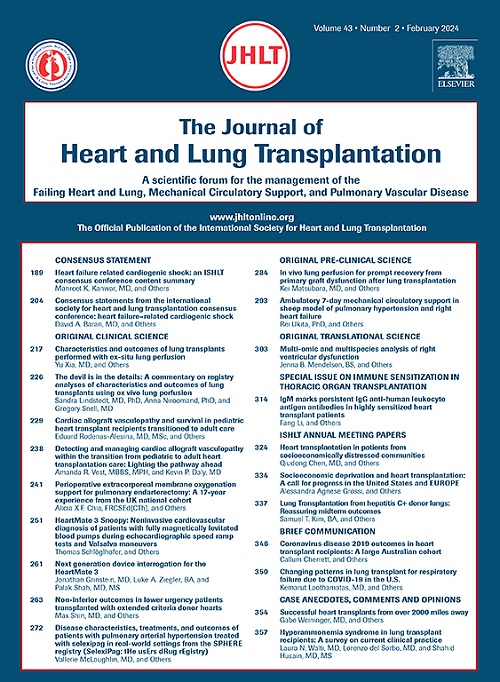“不让心脏掉队”:拯救被丢弃的捐献心脏的全球倡议。
IF 6
1区 医学
Q1 CARDIAC & CARDIOVASCULAR SYSTEMS
引用次数: 0
摘要
尽管心脏移植在技术和后勤方面取得了进步,但每年仍有成千上万的可用供体心脏被丢弃——尤其是在美国——而其他地方的病人继续在等待中死去。这一观点提出了一种全球模式的转变:通过先进的保存技术和互惠分配框架,实现跨大西洋交换未使用的供体心脏。利用欧洲移植和美国的登记数据,我们强调了供体接受标准的显著差异,特别是在年龄较大或先前被认为不太合适的供体方面。我们认为,许多因非生物原因而在当地减少的这些器官,可以安全地移植到不同实践和技术允许使用的地区。保存技术的进步——包括温控静态储存、低温充氧灌注和恒温离体系统——现在允许数千公里的安全运输,挑战了传统的时间和地理限制。我们概述了跨大西洋供体心脏交换系统的伦理、财务和监管先决条件,并提出了早期可行性试验,以启动概念验证共享。这种模式需要透明度、国际监督和公平的“回报”机制来维持信任和平衡。最后,我们认为器官共享的全球整合方法——类似于国际骨髓登记——可以改变移植的可及性,减少等候名单死亡率,并更好地尊重捐赠的礼物。“不让一颗心掉队”不仅仅是一句口号:它是一项有技术可行性支持的道德要求。是时候搭建桥梁了——法律的、后勤的和道德的——使全球心脏交换成为现实。本文章由计算机程序翻译,如有差异,请以英文原文为准。
“No Hearts Left Behind”: A global proposal to rescue discarded donor hearts
Despite technological and logistical progress in heart transplantation, thousands of viable donor hearts are still discarded annually—particularly in the United States—while patients elsewhere continue to die waiting. This viewpoint proposes a global paradigm shift: enabling transatlantic exchange of unused donor hearts through advanced preservation technologies and reciprocal allocation frameworks. Using registry data from Eurotransplant and the United States, we highlight striking disparities in donor acceptance criteria, especially regarding older or donors previously considered less suitable. We argue that many of these organs, declined locally for non-biological reasons, could safely be transplanted in regions where differing practices and technologies allow their use. Advances in preservation—including temperature-controlled static storage, hypothermic oxygenated perfusion, and normothermic ex vivo systems—now permit safe transport over thousands of kilometers, challenging traditional constraints of time and geography. We outline the ethical, financial, and regulatory prerequisites for a transatlantic donor heart exchange system and propose early feasibility trials to initiate proof-of-concept sharing. Such a model would require transparency, international oversight, and an equitable “payback” mechanism to maintain trust and balance. Ultimately, we argue that a globally integrated approach to organ sharing—similar to international marrow registries—could transform access to transplantation, reduce waitlist mortality, and better honor the gift of donation. “No Hearts Left Behind” is more than a slogan: it is an ethical imperative supported by technological feasibility. The time has come to build the bridges—legal, logistical, and moral—that make global heart exchange a reality.
求助全文
通过发布文献求助,成功后即可免费获取论文全文。
去求助
来源期刊
CiteScore
10.10
自引率
6.70%
发文量
1667
审稿时长
69 days
期刊介绍:
The Journal of Heart and Lung Transplantation, the official publication of the International Society for Heart and Lung Transplantation, brings readers essential scholarly and timely information in the field of cardio-pulmonary transplantation, mechanical and biological support of the failing heart, advanced lung disease (including pulmonary vascular disease) and cell replacement therapy. Importantly, the journal also serves as a medium of communication of pre-clinical sciences in all these rapidly expanding areas.

 求助内容:
求助内容: 应助结果提醒方式:
应助结果提醒方式:


